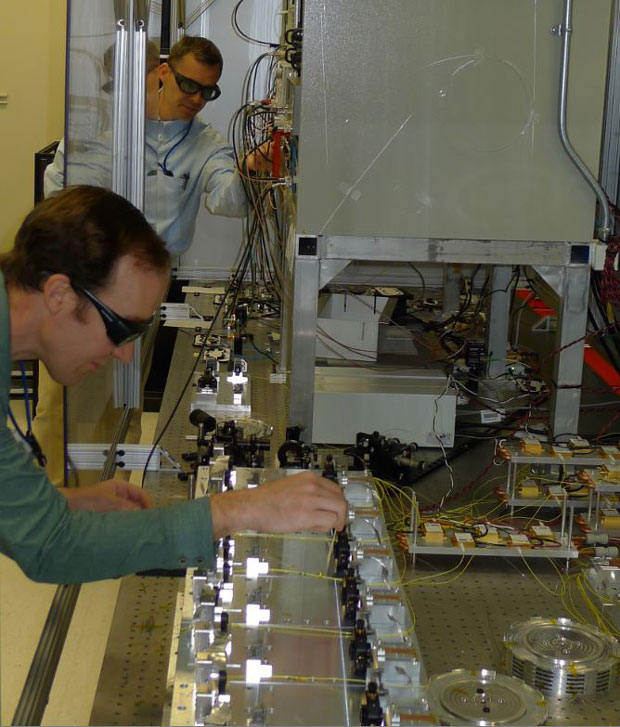Christopher Ebbers (16-ERD-021)
Project Description
High-average-power mid-infrared sources have important roles in national security applications as well as in scientific applications. In addition, they could be employed for active spectroscopic imaging, which is an ideal means for the rapid (millisecond) standoff (at greater than 1 km) detection of toxic, explosive, hazardous, or other contraband substances. Narrowband, rapidly tunable laser sources have shown particular promise for gas and solid species discrimination and identification because of the exceptional spectral brightness of the laser illumination source. For example, a moderate efficiency (less than 5% electrical-to-optical efficiency), diode-pumped, near-infrared laser was successfully used for amplification for widely tunable, narrowband radiation. The next generation of laser sources and active remote sensing systems call for even higher efficiency and lower size, weight, and power requirements and must be able to transition to the 7- to 11-µm region. This spectral fingerprint region has eluded standoff detection exploitation to date because of the difficulty of obtaining pulsed, active sources. We intend to demonstrate a unique Livermore laser, based on fiber-laser pulse source technology, as a pump for high-efficiency, high-power infrared (3–11 µm) sources in both the nanosecond and femtosecond regimes. Sources with high average power and high efficiency in this wavelength region are not yet available with the size, weight, and power requirements or energy efficiency necessary for future applications. We plan to develop high-efficiency and high-average-power mid-infrared pulsed laser sources in two pulse-width regimes: (1) long pulse and narrowband, and (2) ultrafast and broadband. Long-pulse applications include active remote sensing, infrared countermeasures, and remote exploitation. Short-pulse applications include high harmonic generation, pump–probe experiments, and sources for high-energy-density science.
We expect to demonstrate a frequency-agile pulsed laser using the fiber-laser pulse source architecture and parametric converters for a long-pulse (nanosecond) laser at wavelengths of 2, 3.1, and 7 µm, in addition to a short-pulse (femtosecond) laser at 2 and 3.1 µm. We will demonstrate the first chirped-pulse amplification in the mid-infrared range with nanosecond stretched-pulse duration in an efficient and scalable architecture. We intend to enhance the existing Livermore pump laser (fiber-laser pulse source) to higher energy, power, and repetition rate. We will also apply the existing pump to the efficient generation of the high-power, pulsed, mid-infrared source in the nanosecond long-pulse regime as well as the femtosecond ultrafast-pulse regime. We anticipate achieving a tenfold gain in average power and twofold in efficiency over the existing state of the art, which is critical for the next generation of remote sensing, scientific, and national-security applications. In addition, this project is expected to generate intellectual property associated with novel laser architectures.
Mission Relevance
Our research project supports the development of new, efficient, scalable, pulsed-laser technology, which will enhance the Laboratory's core competency in lasers and optical science and technology. This advancement in laser development also supports the Laboratory's cyber security, space, and intelligence mission focus area with technology relevant to remote sensing and exploitation.
FY16 Accomplishments and Results
In FY16 we (1) demonstrated the activation of an all-fiber-laser-based system operating in the shortwave infrared with an energy-scalable architecture (see figure); (2) demonstrated narrowband and tunable seeding in the short-wave infrared, without the need for galvanometers; (3) conceptually developed a potentially high-efficiency parametric conversion scheme based on the characteristics of our all-fiber-laser-based system; and (4) implemented this scheme using surrogate technology.






